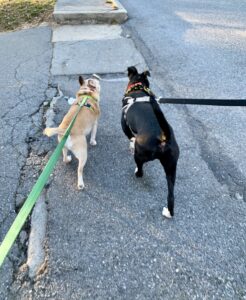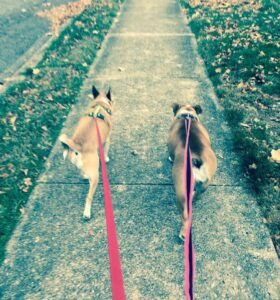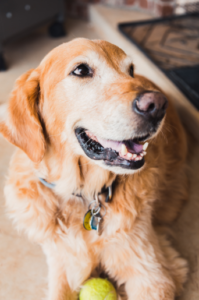by Leann Quire, Director of Shelter Operations, Humane Pennsylvania
It’s finally spring! To some people this might mean that all the snow melted and they now have lots of poop scooping to catch up on in the yard, but it also means nicer weather for more walks with your dog. Going on walks regularly with your dog provides many physical and mental health benefits that help to keep you and your dog loving and living the good life. Below are helpful pet safety tips we recommend to keep you and your dog safe on those beautiful spring strolls.
Collars, Harnesses, and Leashes
Make sure your dog is wearing an appropriate fitted collar or harness. You don’t want to find out the hard way that the collar was too big and your beloved pet slipped out while trying to chase a bicycle or squirrel.
- Use the “two finger” rule by sliding two fingers between your dog’s neck and collar to make sure the collar is not fitted too snug or too loose.
You should not be able to pull the collar up and over the dog’s head. Remember that dogs grow, lose weight, and gain weight just like people do, so it is important to frequently check how your dog’s collar fits and also that it is in good condition.
Harnesses are also great options for smaller breeds and brachycephalic breeds (short nose dogs like pugs and bulldogs) with delicate windpipes. Harnesses can discourage pulling, provide better control, and prevent injury to the neck area. There are MANY different kinds of harnesses, so do your research or work with a professional trainer to identify which harness is best for you and your dog. 
Retractable leashes are generally not safe and are not recommended. Retractable style leashes provide little control and often extend very far, which can be dangerous if you’re near roads or other animals who are not pet friendly. The cord on these leashes are not durable and can snap or easily tangle around the walker or dog and cause serious injury. Talk to your veterinarian or trainer before making the decision to purchase a retractable leash.
Head collars can be a good option for certain dogs who are having difficulty pulling on leash, but if you are looking into this option it is recommended to work with a trainer or veterinary professional to help you acclimate your dog to this style of head harness. Dogs tend to either respond really well or face challenges adjusting to the “funny thing” on their face.
Keep Your Dog on Leash
Most places have laws stating your dog needs to be on leash, and for your dog’s safety it is very important to follow this rule. Even if you have your dog well trained you never know what could scare or spark your dog’s interest and cause them to take off, which puts them at risk of getting hit by a car, in a fight with another animal, or lost. Use designated dog parks that are fenced in for off leash play.
Proper Identification
Not only should you have properly fitted collars and harnesses, but your dog should also have proper identification in the chance they do get loose on your walk. Identification tags with your pets name, your phone number, and city can increase the chance of you reuniting with your pet. In addition, it is highly recommended to get your pet microchipped, which involves a very small chip being inserted under the skin and between your pet’s shoulder blades. This chip has a unique number which is detected by a microchip scanner and entered into a database.
Most shelters, veterinary hospitals, and even police officers carry microchip scanners and can scan a stray animal brought to them. Having your pet’s current rabies tag, license tag, microchip tag, and identification tag are all beneficial and increase the chance of your dog being reunited to you.
Be Prepared with Supplies
Make sure you have poop pick-up bags ready because most cities will issue a fine if you do not clean up after your pet. If you are going on a longer walk or hike it may be good to bring water and treats with you so your dog can stay hydrated and energized.
Environment
Watch the weather and lighting when you go on your walk. Dogs can easily overheat and even moderate temperatures, like 70 degrees, can cause heat stroke depending on the circumstances. Be mindful of your dog’s coat and tolerance to heat. Check with your vet if you are not certain what temperatures you should avoid for walk days. If you are walking very early or very late, make sure you are seen. Put reflective gear and clip on lights that will make you and your dog stand out to a passersby. Play it safe and stay on sidewalks.
Get Cleared by a Veterinarian
Just like when you pop in that new Jillian Michaels DVD to tone in 30 days, Jillian recommends you consult with a doctor or medical professional to ensure you are healthy enough for exercise. The same goes for your pooch. Regular vet visits can make sure that your dog is in sound condition to accompany you on walks. Regular vet visits also mean getting routine vaccinations, which can protect your dog from catching diseases.
Ask Before Approaching
 This goes both ways. If you are walking your dog and see another dog walking by, ask before approaching to let the dogs meet. The other dog may be dog aggressive or be working on their confidence with other dogs, but not quite ready to meet other dogs. Don’t ever assume. Be alert for people who do not practice the “ask before approaching” rule with or without dogs.
This goes both ways. If you are walking your dog and see another dog walking by, ask before approaching to let the dogs meet. The other dog may be dog aggressive or be working on their confidence with other dogs, but not quite ready to meet other dogs. Don’t ever assume. Be alert for people who do not practice the “ask before approaching” rule with or without dogs.
Over the weekend I had two very different interactions when my husband and I were walking our two dogs. The first involved a young child running full speed at my 8 year old pug mix in full Frankenstein fashion with arms stretched out far in front and wide eyes. She was clearly excited and had one goal in mind, to touch the dogs. The child’s parent was nearby and not once intervened. The child approached so quickly my dog snapped at her because he was terrified by the quick approach of a stranger. Thankfully there was no injury or contact. This was not the child’s fault, but the lack of supervision or interference from the parent.
In another situation three children were riding their bicycles and asked from across the street if they could pet my dogs. My dogs are friendly dogs, with the right approach, so I said yes and the children came over slowly and crouched down and offered a hand to sniff. Both dogs were presenting bellies and giving kisses galore. They welcomed this respectful approach. Two different approaches and two different outcomes. Supervise and teach your children appropriate interactions to avoid incidents. If you don’t know confidently how your dog will react in different situations, don’t chance it by allowing strangers to approach.
Walks are a great way to bond with your dog and get some fresh air. Follow these helpful tips to make sure you are protecting yourself and your dog every time you leash up. Next time you ask your dog, “Wanna go for a W.A.L.K?” remember to keep it S.A.F.E.
 Natural
Natural













